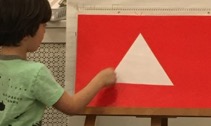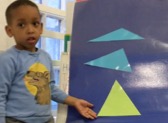Is It Still a Triangle if it’s Not Pointing Upward?
- Triangle is rotated to expand students’ concept of a triangle.
When young children are first introduced to shape categories, like the triangle, they are presented with symmetrical models such as an equilateral triangle (all sides and angles equal in measure). Children are usually shown the equilateral triangle positioned only one way- with one vertex pointed upward, and a horizontal base.
However, research suggests that as soon as these typical examples are introduced, a variety of different positions and sizes should also be shown to children so that their notions of triangles don’t become rigid and limited to only one type of triangle, or a single example of a shape. “Children two to three years of age are not too young for this type of learning” (NCTM, 2010).
“There’s lots of ways you can make a triangle”
Examining various triangles and determining whether or not they are, in fact triangles, leads children to grapple about specific attributes that define what a triangle is (three sides, three corners, straight lines, etc.). As children experience a broader variety of each shape, they begin to build more accurate geometric concepts and ideas. Through this investigation process, the Fours are laying the foundation for geometric discussions that will take place in later grades, such as transformations (rotations, flips, slides), symmetry, and angles.




